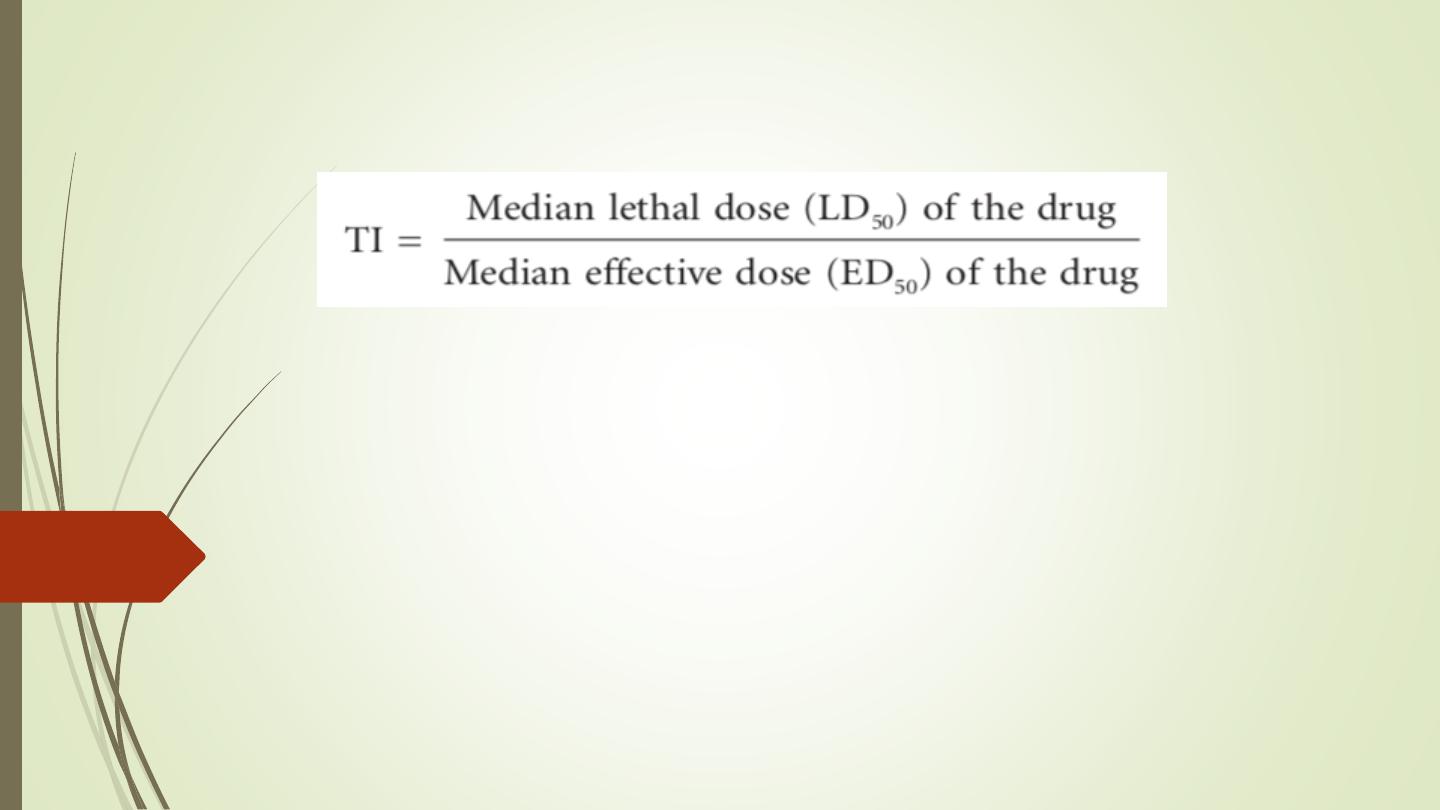
Pharmacology 2
Dentistry College
AL-KITAB UNIVERSITY
DCAU (2019-2020)
Year 3
Dr. SINAN MOHAMMED

Pharmacodynamics
Pharmacodynamics ( Pharmacon: drug; dynamis: power): In short, it
covers all the aspects relating to ‘what the drug does to the body’. It is
the study of drugs—their mechanism of action, pharmacological actions
and adverse effects.
Types of Drug Action
1. Stimulation: Some drugs act by increasing the activity of specialized
cells, e.g. adrenaline stimulates the heart resulting in an increase in heart
rate and force of contraction.
2. Depression: Some drugs act by decreasing the activity of specialized
cells, e.g. general anaesthetics, etc. depress the central nervous system.

3. Irritation: Certain agents on topical application can cause irritation
of the skin and adjacent tissues. When an agent on application to the
skin relieves deep-seated pain, it is known as counterirritant (e.g.
eucalyptus oil, methyl salicylate, etc.). They are useful in sprains, joint
pain, myalgia, etc.
4. Replacement: When there is a deficiency of endogenous
substances, they can be replaced by drugs, e.g. insulin in diabetes
mellitus, thyroxine in myxedema, etc.
5.
Cytotoxic:
Drugs
are
selectively toxic
for
the
infecting
organism/cancer cells, e.g. antibiotics/ anticancer drugs.

Mechanism of Drug Action
A- Non-receptor mediated
B- Receptor mediated
Non-receptor-mediated Mechanisms
1. By physical action:
Demulcent: Cough syrup produces a soothing effect in pharyngitis by coating
the inflamed mucosa.
Radioactivity: Radioactive isotopes emit rays and destroy the tissues, e.g.
131
I in
hyperthyroidism.
2. By chemical action:
e.g. Antacids are weak bases; hence they neutralize acid in the stomach in
peptic ulcer.

3.Through enzymes: Some drugs act either by activating or
inhibiting the enzyme activity. a.
Drug action via enzyme inhibition:
- Angiotensin-converting enzyme inhibitors such as captopril
,enalapril ,etc. act by inhibiting angiotensin converting enzyme
(ACE) and are used in the treatment of hypertension, congestive
cardiac failure, etc.
- Xanthine and hypoxanthine are oxidized to uric acid by the
enzyme xanthine oxidase, which is inhibited by allopurinol.
Allopurinol is used in the treatment of chronic gout to reduce the
synthesis of the uric acid.

4. Through ion channels: Some drugs directly bind to ion channels and
alter the flow of ions, e.g. local anaesthetics block sodium channels in
neuronal membrane to produce local anaesthesia.
5. Through antibody production: Vaccines produce their effect by
stimulating the formation of antibodies, e.g. vaccines against tuberculosis
(BCG), oral polio vaccine, etc.
6. Transporters: Some drugs produce their effect by binding to
transporters. Selective serotonin reuptake inhibitors (SSRIs), bind to 5-HT
transporter and block 5-HT reuptake into neurons and produce
antidepressant effect.
7. Others: Anticancer drugs like cyclophosphamide produce their effect
by binding to nucleic acids.

Receptor-mediated Mechanisms
Receptors are macromolecules present either on the cell surface, cytoplasm or in
the nucleus with which the drug binds and interacts to produce cellular
changes.
Drug–receptor complex Response
For example, adrenergic receptors, cholinergic receptors (muscarinic and
nicotinic), opioid receptors, etc.
Affinity: The ability of the drug to get bound to the receptor is known as affinity.
Intrinsic activity: The ability of the drug to produce pharmacological action
after combining with the receptor is known as intrinsic activity of the drug.

Agonist: A drug that is capable of producing pharmacological action after
binding to the receptor is called an agonist. (e.g. morphine and adrenaline).
Competitive antagonist: A drug that binds to receptors but is not capable of
producing pharmacological action is called an antagonist. (e.g. naloxone and
atropine). It produces receptor blockade.
Partial agonist: A drug that binds to the receptor but produces an effect less
than that of an agonist is called partial agonist. (e.g. pindolol and
buprenorphine).
Inverse agonist: It has full affinity towards the receptor but produces effect
opposite to that of an agonist. For example, benzodiazepines produce
antianxiety and anticonvulsant effects by interacting with its receptors; but E-
carbolines act as inverse agonist at benzodiazepine receptor, and produce
anxiety and convulsions.

Therapeutic index (TI) is an index of drug safety.
It is the ratio of median lethal dose to the median effective dose.
a. LD50: It is the dose of a drug that is lethal for 50% of the population.
b. ED50: It is the dose of the drug that produces desired effect in 50% of
the population.
Wider the value of therapeutic index, safer is the drug. For example,
penicillin has a high therapeutic index; digitalis, lithium and phenytoin
have narrow therapeutic index.

Combined Effects of Drugs
A combination of two or more drugs can result in an increase or a decrease in
response.
Increased response
1. Additive effect: The combined effect of two or more drugs is equal to the sum of
their individual effect.
Effect of drugs A + B = Effect of drug A + Effect of drug B For example, ibuprofen
and paracetamol as analgesic.
2. Potentiation (supra-additive): The enhancement of action of one drug by
another drug that is inactive is called potentiation.
Effect of drugs A + B > Effect of drug A + Effect of drug B For example, levodopa +
carbidopa; acetylcholine + physostigmine.
Carbidopa and physostigmine inhibit the breakdown of levodopa and acetylcholine,
respectively; thus enhancing their effects.

3. Synergism: When two or more drugs are administered simultaneously, their
combined
effect
is
greater
than
that
elicited
by
either
drug
alone.
For example, sulphamethoxazole + trimethoprim.
Decreased response (drug antagonism):
In antagonism, the effect of one drug is decreased or abolished in the presence of
another drug.
- Chemical antagonism: The opposing action of two drugs is due to their chemical
property, e.g. antacids are weak bases that neutralize gastric acid; chelating agents
complex metals and are useful in heavy metal poisoning.
- Physiological (functional) antagonism: Here, two drugs act at different receptors or
by different mechanisms on the same physiological system and produce opposite
effects. For example, insulin and glucagon on blood sugar, adrenaline and histamine on
bronchial smooth muscle—histamine produces bronchoconstriction (via histamine
receptors), whereas adrenaline produces bronchodilatation by acting through adrenergic
receptors—hence adrenaline helps to reverse bronchospasm in anaphylactic shock.

FACTORS MODIFYING DRUG ACTION
There are a number of factors that can influence drug response.
Individuals may often show quantitative variations in drug response,
but rarely show qualitative variations.
DRUG FACTORS
1. Route of administration: When a drug is administered by
different routes, it commonly exhibits quantitative variations; but
sometimes it may also result in qualitative variations in response.
Quantitative variation: Oral dose of the drugs are usually larger than
intravenous dose (since i.v. route produces 100% bioavailability), e.g.
intravenous dose of morphine is 5–10 mg, whereas oral dose is 30–60
mg for analgesic effect.

Qualitative variation: The drug may produce an entirely different response when
administered by different routes. For example, magnesium sulphate orally produces
purgative effect; parenterally it causes CNS depression and locally reduces oedema in
the inflamed area.
2.
Presence of other drugs ) potentiation, synergism and antagonism(
3.Cumulation ) elimination of a drug is slower than the rate of administration(
PATIENT FACTORS
1. Age: In neonates, the metabolizing function of the liver and excretory function of the
kidney is not fully developed, e.g. chloramphenicol can cause grey baby syndrome.
In adults, penicillin G is given sixth hourly; but in infant, it is administered less
frequently as the excretory function is not completely developed.
In the elderly, the renal and hepatic functions progressively decline. The incidence of
adverse effect of drugs is also relatively more and so drug doses have to be reduced
accordingly, e.g. dose of aminoglycosides in elderly is less than normal adult dose.

2. Body weight and body surface: An average dose of a drug is calculated in terms of
body weight (mg/kg).
In obese, lean and in a patient with dehydration or oedema, dose calculation on the basis
of body weight is not very appropriate. A more accurate method for calculating a dose is
on the basis of the body surface area (BSA) of the patient. Nomograms are available to
calculate BSA from height and weight of the patient. Since it is inconvenient to calculate
BSA, routinely dose is calculated on body weight basis. Dose of anticancer drugs and a
few other drugs are calculated on the basis of BSA.
3. Sex: Drugs like b-blockers, diuretics and clonidine can cause decreased libido in
males.
4. Diet and environmental factors: Milk reduces absorption of tetracyclines; fatty meal
increases the absorption of griseofulvin (antifungal agent).
5. Genetic factor
6. Psychological factor: Personality of the doctor as well as the patient can affect
response to a drug. Some patients even respond to inert dosage forms (placebo) in
conditions like pain, bronchial asthma, anxiety, etc.

Placebo effect:
‘Placebo’ is a Latin term that means ‘I will please’. It is a dummy medicine having no
pharmacological activity. The effect produced by placebo is called placebo effect. Sugar
tablets and distilled water injection are used as placebos.
Uses
- Placebos are used for the relief of subjective symptoms like anxiety, headache, tremors,
pain, insomnia, etc.
-
Placebos are used in clinical trials in order to minimize bias.
•Factors affecting placebo effect are:
• Patient factor: Patients with neurotic symptoms often respond to placebos.
• Drug factor: The placebo response can be affected by the physical presentation or
route of administration of the drug. For example, colourful tablets such as red, blue,
green and also injectable preparations give better placebo effect.
• Doctor factor: Personality of the doctor, motivation, way of instruction, doctor–
patient relationship, etc. are important factors that also affect the response to
placebo.

7. Pathological states:
GI disorders: In malabsorption syndrome, the absorption of some drugs is reduced.
Liver disease: In chronic liver diseases, the metabolism of drugs is greatly reduced.
This will increase bioavailability of drugs having high first-pass metabolism, e.g.
propranolol.
Renal failure: Clearance of drugs that are excreted through kidney is impaired. For
example,
the
incidence
of
nephrotoxicity
and
ototoxicity
is
more
with
aminoglycosides in the presence of renal failure.
8.Tolerance: Repeated administration of certain drugs can result in a decrease in
their pharmacological effect. Hence, higher doses of such drugs are needed to
produce a given response, e.g. ephedrine, organic nitrates, opioids, etc. Tolerance
develops to nasal decongestant effect of ephedrine on repeated use. Patients on
organic nitrates for angina develop tolerance on long-term therapy. Tolerance is
commonly seen with drugs like morphine, alcohol, amphetamine, etc.

DRUG INTERACTIONS
When two or more drugs are administered simultaneously, the effects of
one drug may be altered by the other drug.
Drug interactions can occur either in vitro (outside the body) or in vivo
(inside the body). Drug interactions can result in either beneficial or
harmful effects.
Pharmaceutical Interactions
These can occur as a result of incompatibility (physical or chemical) of a
drug with an intravenous solution or when two or more drugs are mixed in
the same syringe/i.v. infusion. This may result in precipitation or
inactivation of one or more drugs.

Pharmacokinetic Interactions
These occur when one drug alters the absorption, distribution,
metabolism or excretion of another drug.
Absorption: Antacids (containing aluminium, magnesium, calcium,
iron, etc.) interfere with the absorption of tetracyclines by forming
unabsorbable complexes with it.
Distribution:
Plasma
protein
binding
can
cause
displacement
interactions. More than one drug can bind to the same site on plasma
protein.
Metabolism: This occurs when metabolism of one drug is increased
(enzyme induction) or decreased (enzyme inhibition) by another drug.

Excretion: Most of them occur in kidneys. Salicylates interfere with
the excretion of methotrexate and potentiate its toxicity. Probenecid
decreases the renal tubular secretion of penicillins and prolongs the
duration of action of penicillins (beneficial interaction).
Pharmacodynamic Interactions
The interaction is due to the action of drugs on receptors or
physiological system. This may result in either additive, synergistic or
antagonistic effects. The interactions may also result in harmful
effects, e.g. enhanced nephrotoxicity seen with the concurrent use of
aminoglycosides and amphotericin B; it may also result in beneficial
effect, e.g. levodopa and carbidopa in parkinsonism.

ADVERSE DRUG REACTIONS
Adverse effect is defined as any undesirable or unwanted effect due to
drug administration. The WHO suggested definition of adverse drug
reactions (ADR) and adverse effects (AE) are as follows:
Adverse drug reaction (ADR): Any response that is noxious,
unintended and which occurs at doses normally used in humans for
prophylaxis, diagnosis or therapy of disease, or for modification of
physiological function (WHO).
Adverse event (AE): Any untoward medical occurrence that may
present during treatment with a pharmaceutical product but that does not
necessarily have causal relationship with this treatment (WHO).

Predictable reactions (Type A or Augmented reactions): These are
predictable reactions to a drug related to its pharmacological actions.
They include side effects, secondary effects and toxic effects.
Unpredictable reactions (Type B or Bizarre reactions): These are
non dose-related unpredictable reactions to a drug. They are not related
to the pharmacological actions of the drug. Allergic reactions and
idiosyncrasy are unpredictable reactions.
Adverse drug effects include the following:
Side Effects
These are the unwanted pharmacological effects of a drug that are seen
with therapeutic doses, e.g. atropine used in the treatment of heart
block also produces dryness of mouth, blurring of vision, urinary
retention, etc., which are the side effects.

Secondary Effects
The primary action of a drug may result in other effects, e.g.
immunosuppression by corticosteroids can lead to development of
opportunistic infections, e.g. oral candidiasis.
Toxic Effects
These are the effects of a drug that are either due to overdosage or
chronic use, e.g. bleeding due to chronic use/overdosage of
anticoagulants and nephrotoxicity with aminoglycosides, especially in
patients with renal failure.
Drug Allergy
It is an abnormal response (local or systemic) to a drug/foreign antigen
mediated by the immune system. Different types of hypersensitivity
reactions are discussed below.

Those associated with humoral antibodies: Types I, II and III.
Those associated with cell-mediated immunity: Type IV (delayed
hypersensitivity).
Type I hypersensitivity (immediate type, anaphylactic shock): It is
a rapidly occurring reaction; hence they are called immediate
hypersensitivity reaction. The manifestations are itching, urticaria, hay
fever, asthma or even anaphylactic shock.
Idiosyncrasy
It is usually a genetically determined abnormal reaction to drugs, e.g.
succinylcholine apnoea, aplastic anaemia caused by chloramphenicol,
haemolytic anaemia seen with primaquine and sulphonamides.

Drug Dependence
Psychological dependence: There is an intense desire to continue
taking the drug as the patients feel that their well-being depends
upon the drug.
Physical dependence: Repeated drug use produces physiological
changes in the body that makes continuous presence of the drug in
the body necessary to maintain normal function. Abrupt stoppage of
the drug results in an imbalance wherein the body has to readjust to
the absence of the drug resulting in the development of signs and
symptoms known as withdrawal syndrome. The withdrawal signs
and symptoms are generally opposite to the effects produced by the
drug.

Iatrogenic Diseases
It is physician-induced disease (‘Iatros’ is a Greek word, means
‘physician’) due to drug therapy, e.g. parkinsonism due to metoclopramide;
acute gastritis and peptic ulcer due to nonsteroidal anti- inflammatory
drugs.
Teratogenicity
Certain drugs when given during pregnancy may cross the placenta and
cause various dangerous effects in the foetus. This is called teratogenesis.
Administration of drugs during early pregnancy (from conception to 16
days) could result in abortion; during 2–8 weeks of gestation, it can affect
organogenesis and produce structural abnormalities; during second and
third trimester, drugs can affect growth and development of the foetus.
Hence, drug administration during pregnancy should be restricted.

Carcinogenicity and Mutagenicity
The ability of a drug to cause cancer is carcinogenicity and the agent
is known as carcinogen. The abnormalities of genetic material in a
cell produced by a drug are known as mutagenicity, e.g. anticancer
drugs.
Photosensitivity Reactions
It is a drug-induced cutaneous reaction following exposure to
ultraviolet radiation, e.g. demeclocycline, doxycycline, etc.
Hepatotoxicity
Some
of
the
hepatotoxic
drugs
are
isoniazid,
rifampicin,
pyrazinamide, halothane, paracetamol, etc.
Nephrotoxicity
Aminoglycosides, amphotericin B, cisplatin, cyclosporine, heavy
metals, etc. are nephrotoxic drugs.

Ototoxicity
It can occur with aminoglycosides, loop diuretics, cisplatin, etc.
Ocular Toxicity
Ethambutol, chloroquine, glucocorticoids, etc. can cause ocular
toxicity.
Pharmacovigilance
It is the science and activities relating to detection, assessment,
understanding and prevention of adverse effects or any other possible
drug-related problems (WHO). The aim of pharmacovigilance is to
improve patient care and safety related to use of drugs, promote
rational use of medicines, develop regulations for use of drugs and
educate healthcare professionals about adverse drug reactions.

Pregnancy safety categories
Category = Description
Category A= studies indicate no risk to the human fetus.
Category B = studies indicate no risk to animal fetus, information in humans is not available.
Category C = adverse effects reported in animal fetus, information in humans is not available.
Category D = possible fetal risk in humans reported, however, considering potential benefit
vs. risk.
Category X = fetal abnormalities reported and positive evidence of fetal risk in humans is
available from animal and/ or human studies. These drugs should not be used in pregnant
women.

